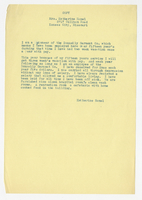The Workers’ Rhetoric: How They Made Their Voices Heard
The workers who wrote letters about their employment at the Donnelly Garment Company (DGC) in 1937 were keenly interested in arguing that the organizational overtures of the International Ladies Garment Workers’ Union (ILGWU) were unwelcome. In their letters, the workers established their credibility as savvy participants in the labor market. They crafted detailed portraits of the working conditions inside the DGC factory. They praised the leadership and generosity of Nell Donnelly Reed. And they reinforced the sense of community shared among DGC workers. As adept with words as they were needle and thread, the letter writers at the DGC collectively crafted a persuasive portrait of their working lives.





